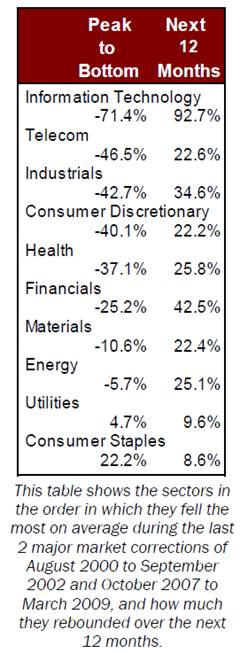Knowledge Centre
Shifting Importance
February 2018
Eventually this bull market will break its long winning streak but that does not mean you should be abandoning everything and running for the hills. What it does mean is that you should consider shifting your portfolio's emphasis. Not all stocks react equally during good and bad times so the secret is to rearrange the deck chairs to ensure smoother sailing.


History never repeats itself exactly but similarities do exist, particularly in the timing of economic events or cycles. These recurring ups and downs in economic activity (or market/business cycles) are made up of several years of peaks, recessions, troughs and eventually a recovery phase. The peak is when business activity has reached its maximum level followed by a slowdown or recession during which business activity reaches its lowest level. The final phase or recovery is when the economy again expands towards maximum output. The movements of the markets are closely linked to the business cycle. Stocks, bonds and commodity prices are heavily influenced by investors' expectations of the future. Each financial market tends to peak and bottom at different points in the business cycle. An expanding economy is generally favourable for the stock market; a weak economy for bond prices; and an inflationary economy for commodities. The overall stock market tends to lead the general economy with stocks going up before the economy peaks and falling before a recession begins. However, the stock market is made up of companies from many sectors which rotate in and out of favour during the phases of the business cycle. The image below shows a typical market cycle and indicates which sectors tend to outperform the broader market at particular times.
Economic recoveries are often led by consumer spending so the retail sector is considered a leader of the broader stock market. It is usually one of the earliest sectors to peak and also to bottom. The same holds for the banking, housing and construction industries which are heavily influenced by interest rates. As interest rates are cut, demand in these sectors grows, as does their stock price.
The table to the left shows the performance of each sector during and after the tech bubble burst in 2000 and the financial meltdown in 2008. The first column has sector performance during these bear phases and the second is the initial recovery phase. The inverse relationship in this case is striking. Those sectors which performed the worst in the falling market tend to increase the most when the market rebounds. Conversely those that had done well during a falling market returned a relatively flat performance when the market recovered. There is a pattern to these rotations which investors can exploit. The industrial and manufacturing sectors usually follow the movement of retail and construction. As inventories become depleted, demand for more manufacturing and industrial output increases. Because the economic environment and news is often bad at this point, investors tend to be cautious and initially invest in companies with good earnings and cash reserves. As the bull market grows, investors tend to place money into relatively speculative stocks such as technology companies. In the later stages of expansion, when interest rates are rising, the capital goods, basic materials, and energy industries tend to thrive as they expand capacity and bid for increasingly scarce resources.
Value stocks tend to outperform by falling less during bear markets and growth stocks tend to outperform in the bullish phase. Of course, there are many permutations that push and pull markets. Being right all the time is next to impossible but shifting a portfolio's exposure between sectors can go a long way to minimizing the damage when financial gravity reasserts itself.
MARKET DATA

This report may contain forward looking statements. Forward looking statements are not guarantees of future performance as actual events and results could differ materially from those expressed or implied. The information in this publication does not constitute investment advice by Provisus Wealth Management Limited and is provided for informational purposes only and therefore is not an offer to buy or sell securities. Past performance may not be indicative of future results. While every effort has been made to ensure the correctness of the numbers and data presented, Provisus Wealth Management does not warrant the accuracy of the data in this publication. This publication is for informational purposes only.
Contact Us
"*" indicates required fields
18 King St. East Suite 303
Toronto, ON
M5C 1C4
